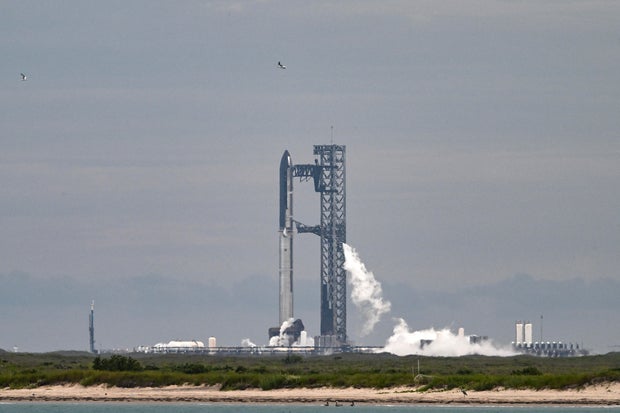SpaceX readied its huge Super Heavy-Starship rocket for a second launch try on Monday to kick off the program’s 10th test flight, a milestone mission to put corrective upgrades through their paces after three catastrophic failures earlier this year.
A successful flight would help restore confidence in the gargantuan rocket amid growing concern a moon lander variant being built for NASA may not be perfected in time for a planned 2027 landing and possibly not before the Chinese mount their own piloted moon mission at the end of the decade.
But in the near term, SpaceX’s goal was to get the Super Heavy-Starship flying again after multiple back-to-back failures.
A launch attempt Sunday was called off because of trouble with a ground system at the company’s Starbase flight test and manufacturing facility on the Texas Gulf Coast. But that problem was quickly corrected and blastoff was reset for 7:30 p.m. EDT Monday.
RONALDO SCHEMIDT/AFP via Getty Images
The goals of the flight were to test the Super Heavy first stage under a variety of stressful flight conditions, deliberately shutting engines down during descent to splashdown in the Gulf to make sure it can handle real failures during an actual mission.
Given the nature of the tests, SpaceX ruled out a dramatic return to the launch pad for a mid-air capture by giant mechanical arms on the support gantry.
As for the Starship, the flight plan called for sending the upper stage halfway around the world on a sub-orbital trajectory to a controlled re-entry and splashdown in the Indian Ocean.
Along the way, a variety of tests were planned, including the deployment of eight Starlink simulator satellites and an in-space restart of a methane-fueled Raptor engine. Modified heat shield tiles were in place and a few were even removed to determine the effects of extreme re-entry temperatures on the rocket’s structure.
Multiple upgrades also were in place to minimize the chances of propellant leaks, fires and engine shutdowns like those that led to the loss of the last three Starships launched, none of which was able to complete its mission.
RONALDO SCHEMIDT/AFP via Getty Images
While a successful test flight this time around might ease concerns about the viability of the Super Heavy-Starship for future moon missions, it’s unlikely to eliminate them.
The moon lander variant will use most of its propellant just to reach low-Earth orbit. For a flight to the moon, SpaceX will have to launch 10 to 20 Super Heavy-Starship tanker flights in rapid succession to top off the lander’s tanks. A single failure would almost certainly require a mission restart.
And even if SpaceX’s achieves the required launch cadence, no one has ever attempted cryogenic propellant transfers on that scale in orbit.
And there is no flight-proven technology to minimize, if not eliminate, the otherwise unavoidable loss of propellants as the super-cold liquids naturally warm in space, boiling off and turning into gas that must be vented overboard.
Most observers believe SpaceX will eventually overcome the hurdles ahead. The question is, can the vehicle be perfected in time for a 2027 moon landing?
Secretary of Transportation Sean Duffy, NASA’s acting administrator, is optimistic SpaceX will be ready to fly.
“If you look at the company as a whole and past performance, they often times are behind, and then all of a sudden, they make these massive leaps forward,” he said in an interview with CBS News. “I would be hard pressed to say they’re not going to meet the goals and the timelines.”
“Their leadership has said we feel very confident that we are going to be ready for the mission,” he said. “And so I’ll take them at their word.”
CBS News interviewed multiple current and former NASA and contractor managers and engineers in recent weeks who unanimously agreed a landing in 2027 could not be safely carried out with the current architecture.
And not one of them said they believed NASA could get there before the Chinese without a drastic change of course.
“I think the folks you’ve talked to are accurate. We are not going to go ahead and get a crewed Starship to the moon by 2030, under any circumstances,” said a senior engineer who worked on the Artemis program.
“That doesn’t mean they’ll never get there. That doesn’t mean the architecture couldn’t work. But it’s just too big of a technical leap to accomplish in the short time that we’ve got.”
But as Duffy pointed out, SpaceX has chalked up a remarkable record with its partially reusable Falcon family of rockets, launching them at an unmatched pace that allows the company to rapidly implement and test upgrades and fixes.
As of Friday, SpaceX had launched 518 Falcon 9s and 11 triple-core Falcon Heavy rockets with just two in-flight failures. The company has successfully recovered first-stage boosters 490 times.
Given its record, many fans give SpaceX the benefit of the doubt when it comes to the Super Heavy-Starship. But the giant rocket dwarfs the Falcon 9, and the requirements for a successful moon landing are well beyond those faced in a typical satellite launcher.
“My concerns have to do with how complicated the mission architecture is, how many flights there are to send a single lander to the moon,” said Douglas Cooke, a retired 38-year NASA veteran who now does consulting work for Boeing and other aerospace concerns.
“Getting into the high numbers,” he added, “reduces the probability of success.”
SpaceX did not respond to a request for comment.
Source link



